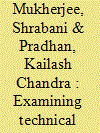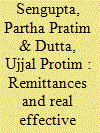|
|
|
Sort Order |
|
|
|
Items / Page
|
|
|
|
|
|
|
| Srl | Item |
| 1 |
ID:
159809


|
|
|
|
|
| Summary/Abstract |
This article examines the nature of spatial dimensions of poverty in Bangladesh by undertaking an in-depth investigation of inter-temporal divergence and convergence in poverty levels. Based on the estimations of Alkire–Foster Multidimensional Poverty Index (A–F MPI) for selected years, the article compares trends in broader dimensions of spatial poverty in Bangladesh with income poverty trends available for corresponding periods. The article scrutinizes the validity of the so-called ‘East–West divide’ in view of poverty levels in Bangladesh. The results evince a number of interesting insights. First, trends of income poverty in Bangladesh are not aligned with those of multidimensional poverty. Second, the levels of inter-temporal poverty as per MPI are relatively higher for the rural–urban divide and also at sub-national (division) levels. Third, inter-temporal trends of divergence–convergence in terms of income poverty relating to the East–West divide do not match corresponding movements in MPI. It is argued that while income poverty dimensions remain important, policymakers should pay more attention to broader issues of deprivations to address challenges of poverty in Bangladesh. Therefore, addressing causes of deprivations as captured in MPIs will help achieve balanced spatial development, accelerated poverty reduction and lower income inequality in Bangladesh.
|
|
|
|
|
|
|
|
|
|
|
|
|
|
|
|
| 2 |
ID:
159808


|
|
|
|
|
| Summary/Abstract |
This article investigates the impact of casualization on the labour market of organized manufacturing industries in India. In specific, this article analyses the impact of casualization on the labour demand and output elasticity of 15 manufacturing industries in the post-liberalization period for the direct production workers. Dynamic panel data analysis of system generalized methods of moment method is used here for the estimation of lagged labour demand for permanent production workers. Aggregate level analysis ensures that casualization has a significant positive impact on the labour demand and on output elasticity. Disaggregate level analysis also confirms the significant positive impact on the output elasticity at individual industry level. However, wage share of the workers falls along with the increase in the usage of contract workers across most of the industries. Output elasticity increases but at the cost of falling wage share. Casualization generates more job opportunity but reduces the wage share for the permanent production workers in post-liberalization period.
|
|
|
|
|
|
|
|
|
|
|
|
|
|
|
|
| 3 |
ID:
159806


|
|
|
|
|
| Summary/Abstract |
Despite improvements in food production, many rural households in Bangladesh are still food insecure, and this requires urgent policy intervention if the situation is to improve. This article examines the factors influencing food security of vulnerable rural riverine households in Bangladesh. The results reveal that riverine households’ lack of access to many basic necessities and services, such as food, safe drinking water, education and health, results in increased vulnerability to food insecurity which could lead to an unfortunate vicious cycle of poverty. Model results indicate that household heads’ education, household size, adoption of livestock and access to non-farm earnings also affect food security. More importantly, evidence suggests that access to improved health care also needs policy support in parallel with improved access to food to achieve and sustain long-term food security in Bangladesh.
|
|
|
|
|
|
|
|
|
|
|
|
|
|
|
|
| 4 |
ID:
159807


|
|
|
|
|
| Summary/Abstract |
This article presents a quantitative analysis of growth, structural change and employment linkages at the aggregate level and by sector under the state- and market-led regimes in India. The underlying objectives are: (a) to understand how economic liberalization has affected the economic and labour market structures, and linkages thereof; and (b) to analyse how these dynamics have affected the generation of productive employment in the economy. The analysis is based on Shapley decompositions. Our results suggest that the contribution of structural change in employment to growth declined drastically and secularly as the country transitioned to a high-growth regime driven by globalization. The sector-level analysis indicates that employment opportunities are not being created in high-productivity sectors and segments. Thus, despite a high-growth rate in GDP per capita and productivity-enhancing structural transformation in GDP, a vast population is still trapped in employment that cannot be qualified as productive employment. The study attributes it to trade-induced economic specialization accompanied with weakening of internal inter-sectoral linkages. The article makes a strong case for strategic government intervention to broad base structural change for generating productive employment, which is at the core of poverty reduction.
|
|
|
|
|
|
|
|
|
|
|
|
|
|
|
|
| 5 |
ID:
159805


|
|
|
|
|
| Summary/Abstract |
The study estimates the technical efficiency (TE) of agricultural production in India using production frontier model for both cross-section and panel data for the years 1999 and 2007. Given the persistent low productivity of agriculture in India, there is a serious need to identify the determining factors for technological lock-in for agricultural production in order to accelerate sustainable productivity and technical efficiency. The model claims that farmer’s education, household’s production process, proportion of irrigated area covered by canals, availability of wells, yielding variety of lands, government services, agricultural expenditure by local government and women reservations in local government significantly contribute to efficiency in resource utilization in farm production. Traditional techniques such as ‘learning by doing’ is, generally, preferred than the adoption of new technologies for agricultural production. It makes a constraint of technological lock-in.
|
|
|
|
|
|
|
|
|
|
|
|
|
|
|
|
| 6 |
ID:
159810


|
|
|
|
|
| Summary/Abstract |
Remittances in India have been growing rapidly since 1991. Most of the studies find that remittance has had a significant impact on real effective exchange rate (REER). It is imperative to evaluate the impact of a transfer such as remittance and aid on country’s competitiveness. This article is an attempt to investigate the impact of workers’ remittances and some selected macro-variables on REER of India using annual data from 1980–2015. The study conducted autoregressive distributive lag (ARDL) bound test co-integration approach to explore this long-run relationship. The ARDL bound test approach confirms significant long-run relationships among the selected variables at 1 per cent level of significance. In addition to this, the ARDL short-run error correction model implies that while REER may temporarily deviate from its long-run equilibrium, the deviations adjust towards the equilibrium level in the long run.
|
|
|
|
|
|
|
|
|
|
|
|
|
|
|
|
| 7 |
ID:
159804


|
|
|
|
|
| Summary/Abstract |
The study assesses the sustainability of current accounts for the panel of five major South Asian economies, namely, India, Pakistan, Bangladesh, Sri Lanka and Nepal for the period 1985–2016. Towards this end, the intertemporal solvency model of Hakkio and Rush (1991) and Husted (1992) has been employed. The panel co-integration test by Westerlund (2007) confirms the long-run relationship between exports and imports but the estimates of the slope coefficient based on GM-FMOLS, GM-DOLS and CCEMG turn out to be less than one indicating the weak sustainability. The weak form of sustainability implies that current account inflows are not equally matched by the outflows underscoring the need for policy interventions. An analysis of the other fundamentals, however, reveals that the non-consumption-dominated import structure, increasing export diversification and broadly declining external debt stocks are welcome signs for the external sustainability of the region.
|
|
|
|
|
|
|
|
|
|
|
|
|
|
|
|
|
|
|
|
|